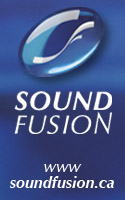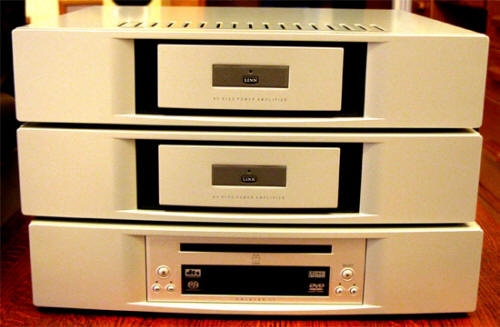|
|
DAVID ROBINSON'S SYSTEM
LOUDSPEAKERS
Von Schweikert
VR-5 SE loudspeakers outfitted with Walker Audio Reference High Definition
Links (HDLs) on both upper and lower bi-wires; Nova Rendition II
loudspeakers outfitted with Walker Audio Reference HDLs on the upper and
lower bi-wires, and Townshend Audio Supertweeters; all contacts treated with
Walker Audio Extreme SST Contact Enhancer.
ELECTRONICS
LAMM 1.2
hybrid monoblock amplifiers; Linn Klimax monoblock amplifiers; Joule
Electra LA-150 line stage preamplifier; EMM Labs DCC2 Signature Edition
preamplifier and Digital Converter; Linn Klimax Kontrol preamp; deHavilland
Mercury II preamplifier; Walker Audio Reference Phono Amplifier with all the
latest mods (as of 10/25/06); Joule Electra OPS-2 dual mono phono amplifier;
Aesthetix Rhea phono amplifier; E.A.R. 324 phono amplifier.
SOURCES
DIGITAL:
EMM Labs CDSD Signature SACD/CD Transport; Teac Esoteric X-01 SACD/CD
player; Teac UX-1 Universal player; EMM Labs Philips SACD 1000 w/optical DSD
and PCM output (2/6 channel); Theta Digital Pro Gen Va D/A converter;
Panasonic SV-3900 DAT player with Vimak DS-500 A/D converter.
ANALOG: Walker Audio Proscenium Black Diamond reference turntable
system with the Black Diamond Arm, the Magic Diamond cartridge, and direct
connection to the Walker Audio Reference Phono Amp (upgraded to the latest
version, with the Walker Audio Power Supply, Second Edition, also upgraded
to the latest revision, both as of 10/24/06); Linn LP-12 turntable, with the
Akiva reference cartridge, Ekos tonearm, the new Lingo power supply, Cirkus
subchassis, and Linn reference silver phono cable; Revox B-77 Mk. II 15 ips
half-track reel-to-reel tape recorder; Pioneer RT-707 7.5 ips quarter track
reel-to-reel tape recorder; Nakamichi Dragon reference cassette deck; Magnum
Dynalab FT-101 tuner w/Audioprism 6500 internal antenna.
HEADPHONES
Beyer Dynamic DT-990 headphones.
CABLES
Interconnects by
JENA Labs, Cardas, Harmonic Technology, Empirical Audio, Stereovox, and
Linn. Speaker cables by JENA Labs, Cardas, and Linn. Power cables by JENA
Labs, Cardas, First Impression Music, Silent Source, and VansEvers.
ACCESSORIES
Grand Prix Audio
Monaco Modular Rack; Walker Audio Prologue Rack; Walker Audio Prologue
Turntable Stand; Walker Audio Prologue Amplifier Stands; Critical Mass
Systems Grandmaster Rack; Critical Mass Systems Grandmaster Amplifier
Stands; Walker Audio Valid Points and Valid Points tuning kits; three Walker
Audio Velocitors on Velocitor Stands (line conditioning for Walker Audio
Proscenium turntable system and its associated Linn Kontrol and deHavilland
Mercury II preamps); AirTight Disc (LP) Flattener; Digital Systems and
Solutions RealityCheck™ CD duplicator; Vibraplane turntable isolation
platform; Sistrum SP-101 amplifier stands and SP-4 multiple platform rack;
Black Diamond Racing "The Shelf" and cones; audiodharma Cable Cooker 2.5;
Gryphon Exorcist system demagnetizer; Extremephono VCS Platforms w/Black
Diamond Racing cones; Dedicated Audio Cable Tower cable supports; additional
equipment racks by Michael Green; Shakti Stones and Shakti Onlines;
VansEvers Clean Line; VPI 17F LP cleaning system with the latest Walker Record
Cleaning Solutions; Walker Audio Extreme SST Contact Enhancer; Walker Audio
Ultra Vivid SACD/DVD/CD enhancer; Furutech RD-2 SACD/DVD/CD
demagnetizer; Furutech DeMag LP/SACD/DVD/CD degausser; acoustical treatments
by ASC, NuCore, VansEvers, and Michael Green.
|
|
Way-back Machine Time: History
Compressed by Extreme Acceleration
"Sherman, set the way-back machine for the
1950s through the mid-1970s. We'll visit the earlier years of
television."
"OK, Mr. Peabody."
[And a younger generation or two of PFO
readers immediately pop open a Google session to find out who the heck
"Sherman" and "Mr. Peabody" are…]
In the halcyon days of yore, fine audio
existed in either monomaniacal mono (days that I barely recall) or that
generally preferable option, stereo. "Home theater" didn't exist as a
category—you went to the movies if you wanted "theater." That was the
only place that you could get air conditioning, big sound (including
various early essays into surround sound…remember the first time you saw
2001?), big picture, and complete immersion into the experience
of film.
Home? Heck, that was where you watched
television if you had it; there was absolutely nothing theatrical
about it. "Home theater" would have been an oxymoron, given the
philosophy of the TV network moguls, movie distribution, and general
video/audio technology of the time. Watching television meant being
subjected to the dictates of the big three networks (ABC, CBS, and NBC)
as to what was viewed, when it was viewed, and how it would be chopped
up to allow wonderful dollops of advertising to massage your mind.
(Interested readers are directed to Stuart Ewen's classic work,
Captains of Consciousness: Advertising and the Social Roots of the
Consumer Culture for more on this disheartening topic.) Television
was quite often seen in black and white, like it or not, while color
sets of the 60s and very early 70s were generally execrable in their
color rendition and (often) their reliability.
Let's leave the Way-Back Machine,
Sherman.
By the late 70s things began to change.
Color TVs achieved a noticeably higher degree of color fidelity, and
became more reliable. Cable systems sprouted in metropolitan areas
around the country, improving image and audio quality over the
uncertainties of rabbit ears or roof-top antennas. Cable-based networks
used this new infrastructure to bring new specialty programming, thus
liberating viewers from the lock that the Big Three had on content
during the prior three decades. The parallel advent of consumer-grade
VCRs (both Beta and VHS) made the handling of video tape quite simple
(just like cassettes had done vis-à-vis open reel tape), allowed
consumers much greater latitude in their video fare, and acceptable
quality consumer playback, to boot. With the US Congress's blessing of a
suitable fair use doctrine, the time shifting of taped content could
become both legal and commonplace. It was now possible to set up stereo
audio playback with your VCR and color TV, enhancing both video and
audio. The television experience was morphing into some more than an
evening with the idiot box …but it wasn't nearly "theater" yet.
In the 1980s, Beta faded and VHS thrived, a
fine example of the format with lesser quality triumphing in the
marketplace. (Sony waited too long to get longer capacity tapes onto the
market.) The development of S-VHS would eventually remove many of the
criticisms of the format when it came to home taping, though S-VHS never
became common in the pre-recorded market. Meanwhile, the arrival of
laserdisc technology in the 80s provided a superior optical format for
pre-recorded movies, with noticeably higher fidelity than most VCR's
could match. Many videophiles, yours truly included, bought into the
laserdisc format rather than tapes, since they were higher quality and
more robust. (I've owned four or five laserdisc transports, two of
which—a Theta Data III and a Pioneer unit—I still use.)
Laserdisc's run as the videophile source of
choice lasted from the mid-80s to the later 90s. The late 90s brought
the arrival of the DVD disc, with its smaller form factor and its
digital video encoding. (Many folks still do not know that the video
signal on laserdiscs was actually an analog one.) It took more
than just a few years for DVD's to catch on…laserdiscs would persist
until 3-4 years ago …and VHS was still highly popular among the general
public until 2-3 years ago. That's when the great sea-change occurred,
and DVDs truly began to displace both laserdiscs and VHS.
Parallel to this video development was the
honing of surround sound for this new and very promising market. Dolby
Surround™, Dolby Digital™ and AC-3, THX™ certification, clever DSPs to
simulate various kind of "hall sounds" …all these drove a burgeoning
market in 5.1 channel for the home. A number of manufacturers jumped on
the bandwagon that rolled out: compact speakers and subs, in-wall
installation, active speakers, and even full-house/multi-room systems,
mixing surround and stereo deployments. Both later generation laserdiscs
and the newer DVDs quickly deployed these surround specifications in
response to a growing consumer demand for an improved audio experience
in the home—one that would be "theater-like."
Meanwhile, optical disc and television
technology have played the push-pull game over the past 5-6 years. The
DVD format pushed television manufacturers (and, for that matter,
computer manufacturers) to produce sets/monitors that could handle
higher resolution feeds (400+ lines) and better interfaces with truer
color rendition and much higher resolution (from RCA composite to
S-Video to RCA component to BNC component to DVI/HDMI). Television, in
turn, upped the ante by jumping past the venerable NTSC standard
entirely, and going to a much higher resolution standard.
"What the people want": HDTV
Which is how we ended up with HDTV. The
arrival of high definition TV (HDTV) in the Portland area around 1999
was emblematic of a truly massive format change, from the foundational
television format in the USA of NTSC (approaching 400 scan lines if you
had a good set, well calibrated) to the new 720p/1080i and even 1080p
resolutions. The next big thing will be the arrival of optical formats
for HDTV: Sony's Blu-Ray, and the rival HD-DVD. (Yeesh. "Format Wars"
redux.) These HD formats are the predictable results of the
push-pull game from television to optical and back again. And optical
formats themselves will have to fight the war against high-bandwidth
on-demand streaming media via broadband in urban/suburban settings, as
well as hard disk-based multimedia servers in the home. We'll be
digesting the implications of these changes for the next 5-10 years, as
their deployment has already begun this year.
Audiophiles will (and do) debate the merit
of various audio formats, but in the realm of videophilia, there is no
question about it …HDTV is the wave of the future. Even the most
died-in-the-wool NTSC user is generally knocked out by a good HDTV
setup, and as the prices have come down dramatically, and TV
networks/stations scramble to deploy FCC mandated parallel digital TV
systems, consumer interest is rising. (Unlike, say, the dreary consumer
drift from CDs to compressed downloadable music, a definite step
downward from the striking possibilities of DSD and SACD.) SACD will be
an audiophile format, like specialty LPs (unless Sony/UMG/etc. get off
their backsides and take the now unlikely step of doing a total
inventory conversion to hybrid SACD, a step long overdue); HDTV will
become the mass standard within the next five years or so. For those of
us who love home theater, this is a good thing! (For those of us who
hate change of any kind, I guess this is a bad thing. Uncle Mort really
did want to be buried with his RCA, you know. All believers in que no
haya novedad get to step to the rear of the bus.)
As a matter of fact, I have been following
HDTV's development since the early 90s; once the new standard went into
production, I got into the game. Since Portland was an early test market
for broadcast HDTV, I purchased my first HDTV, a Toshiba 65"
rear-projection HD-ready with separate HD broadcast tuner, in the fall
of 1999. (I calibrated this with the Video Essentials Disc on
laserdisc, since supplemented by the Digital Video Essentials
DVD. This is an absolutely critical step to take with any video playback
system; uncalibrated video systems destroy much of the capability of
your video system. Check amazon.com or your favorite video emporium for
this DVD.) This has since been upgraded by the addition of a Mitsubishi
S-VHS/D-VHS (digital HD tape format) VCR and a Comcast HD cable with
digital video recorder (DVR). Over time, the DVR has become my primary
recording format for video, with the video tape system demoted to
archiving purposes and tape playback. The ease, convenience, integrated
programmability, and multi-tasking capabilities of the DVR (simultaneous
playback while recording, or recording up to two programs at the same
time) together with its high speed access of recorded material make it
the platform of choice for video recording in this household. I suspect
that most American users will find the same to be true, which means that
HD + DVR will eventually win both the video standards and
"time-shifting" wars.
I guess you could say that I really enjoy
home theater. I find that it's a completely separate gestalt,
quite distinct from what I look for or experience in my listening room.
I therefore keep them in two different spaces; the home theater
downstairs, in the great room, while the listening room is housed
upstairs. Not everyone has this luxury, and compromises are quite often
required by our circumstances in life, but I had the opportunity to
divide the two, and have done so.
Up until the arrival of the Linn reference
surround system discussed in this article, I had already owned three
systems of varying quality …some Yamaha gear, a Pioneer/Pioneer Elite
system, a Panasonic SAO monitor, and the usual bevy of Sonys. Each
generation was a decent step forward…
…but then came Linn
In the summer of 2004, I discussed doing a
home theater/surround sound project with Brian Morris of Linn. I had
seen the Linn Kisto/Unidisk/Akurate/5125 amplifier system debut in
Seattle at Definitive Audio all the way back in the fall of 2003 (see my
photo essay in Positive Feedback Online, Issue 8, at
https://positive-feedback.com/Issue8/linn.htm), and was eager to
hear the results in my home theater room here in Portland. Linn was
willing to do the project, but it would take some time for them to get
the gear my way.
As it turned out, it was about a year later
that the Kisto, Unidisk 1.1 universal player, a pair of 5125 switching
amps, and the Akurate 242/225/212 speaker system arrived. (The Melodik
Subwoofer was already in place.) It was quite a pallet of gear; as
usual, Linn had done an impeccable job of packaging for shipment, with
not a single item experiencing any biffs or bruises. Anyone with much
time on the clock dealing with fine audio gear being shipped knows how
much of an achievement this is—you might be surprised at how often
expensive gear takes it in the chops when it isn't properly parceled.
Brian Morris flew out shortly thereafter to assemble the components and
help dial in the complexities of the Kisto controller.
As far as the setting was concerned, our
home offers only one acceptable site for home theater/surround sound:
our great room. The dimensions are pretty decent, being 18' wide by 24'
long, with a peaked and vaulted ceiling along the long axis that's 16'
high at the center. Unfortunately, our fireplace forced a shift to the
left of the front end of the system. This unhappily skews the sound
somewhat (traditional designs certainly were not developed for home
theater, it's clear), but I find that it still allows for a satisfying
home theater/surround sound experience.
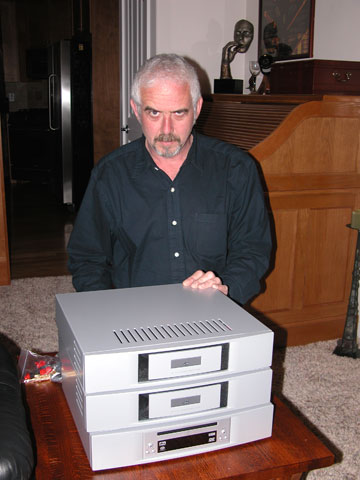
Brian Morris shares his Dr. Svengali-like
gaze with Ye Olde Editor…
The first task was to clear out the audio
section of my old home theater system. Out went the Yamaha surround
receiver/amp, a Sony DVD player, the TC Audio front left/right speakers,
and the NHT center channel. The 10" in-ceiling rear speakers were
disconnected, as well. Also out, my vintage 1997 Bell'Ogetti equipment
stand …handsome, but not very solid, and very "hard" sounding. Out it
went.
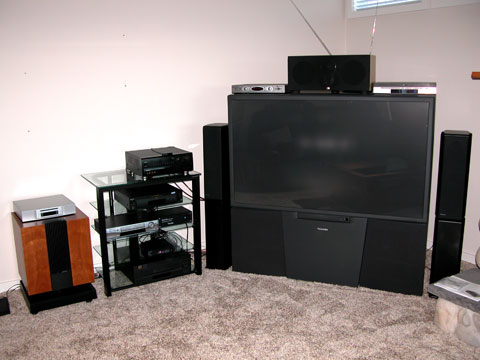
In the beginning - the old gear before
being moved out.
In its place we deployed the Linn gear. At
the heart of the Linn system is the Kisto, a remarkable control unit and
audio processor. It supports just about every audio option you might
like in stereo, Dolby 5.1 and Dolby, DTS, DVD-A in stereo or
multichannel, and SACD two/three/four/six channel. The Kisto
auto-detects the incoming audio signal and switches to the appropriate
decoding for that signal, a very handy feature in the current
bewildering audio-video environment of competing and confusing
standards.
The Kisto is a beautiful piece of work, but
setting one up is not for the faint of heart. The documentation is very
good …typical of Linn …but this component is very complex. I assisted
Brian in the setup, and was able to learn the body English of the menu
structure in a reasonable amount of time. (Then again, as an IT
professional in my secret life, I'm probably a lot more comfortable with
menus and flying the controls of the Kisto than many end users would
be.) Having gone through this, I would recommend that anyone planning on
purchasing a Kisto have an experienced Linn installer do the work for
you. Which I was very glad to let Brian do.
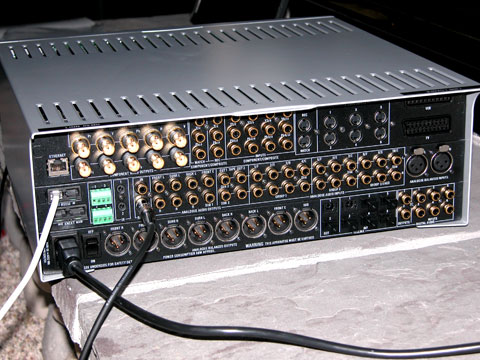
I/O, I/O, so off to work we go! A glimpse
of the incredible input/output options on the rear of the Linn Kisto, as
Brian Morris began the work of cabling the beastie.
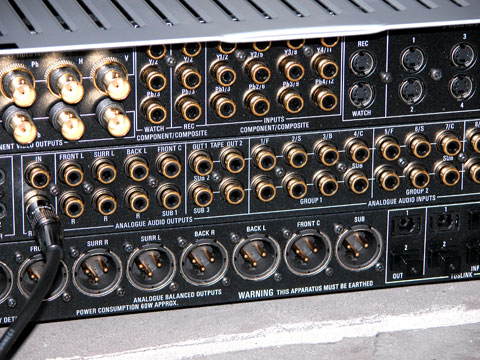
A closer view: let's see, two complete
sets of BNCs, six s-video, three sets of component video, surround I/O
in RCA and XLR …what's not to like, Maynard?
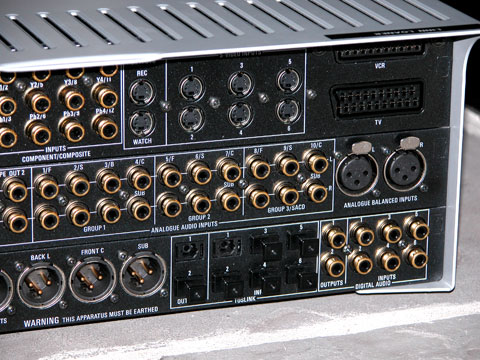
Another look, further right: six RCA
digital inputs and 2 RCA digital outputs, and six (!) TOSLINK
inputs with two TOSLINK outputs. Analog left/right XLR inputs. Not much
missing here. In fact, the only thing missing from the Kisto as far as I
could tell was video I/O for DVI and HDMI. On the other hand, SCART is
included, but is of interest in the European market, and not in the USA.
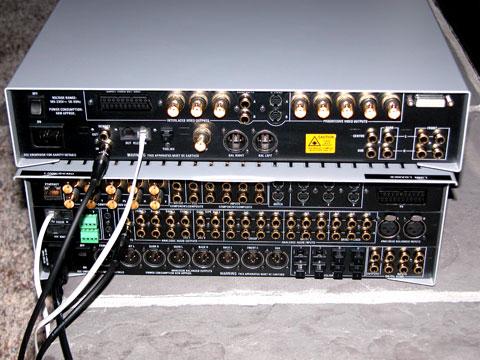
The Linn Unidisk 1.1 universal player
deployed on top of the Kisto for control cable preparation. The final
placement of the Unidisk was not on the top of the Kisto, though
…it has its own shelf …to avoid thermal overload.
The Kisto has a complete set of control
I/Os that allow it to act as a center for all of the associated Linn
gear. Linn's smashing Unidisk 1.1 universal player plugs into the Kisto
for all audio and video output. In the configuration here, we set up the
video output from the Unidisk via three interlaced BNC's (top row to the
left above), using BNC to RCA adapters and running video cabling to the
component inputs on the Kisto. Surround audio out was piped via six RCA
outputs on the Unidisk to the Kisto. PCM S/PDIF via coax was used to
output PCM, though we could have just as easily gone with XLR. Due to
I/O limitations on my older HDTV, I wasn't able to connect the BNC's for
progressive video, something that I would have done in a heartbeat if it
had been possible. An RS-232 input pipe via twisted pair and an RCA
remote control input via RCA rounded out the cabling between the Unidisk
1.1 and the Kisto.
Once basic cabling was checked, Brian and I
set the Kisto on one shelf of its new stand, and the Unidisk 1.1 on the
next shelf down. The reason for this is quite simple, and important for
our readers to understand: the Kisto and Unidisk 1.1 do run very warm,
and require sufficient space to properly ventilate. Unlike some mid-fi
stackables, these components are extremely sophisticated devices which
generate significant levels of heat. Not only should they not be stacked
directly on top of each other, you must plan for shelving or cabinet
system that allows adequate spacing and air flow. I think I can quite
safely say that failure to do so is inviting a very nasty thermal
failure.
Surround amplification was provided by a
pair of Linn 5125 five channel amplifiers, wired in parallel. (During
the extended course of this review, the 5125 was superseded by the
Chakra series, with the C5100 mapping most closely to the earlier 5125.)
In this configuration, each of the five channels was supplied with
approximately 200 watts of power. The older Melodik subwoofer, no longer
in production but which was used for this project, had its own dedicated
amplifier with 200 watts for the lower end.
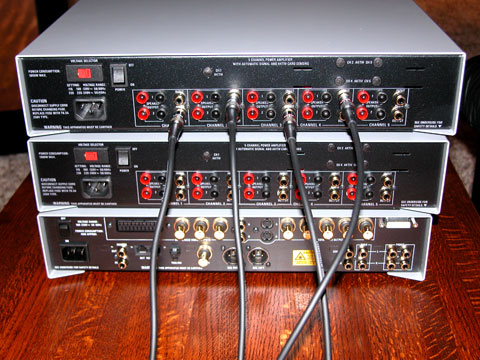
Brian Morris begins the bi-amping of the
Linn 5125 amps; this will produce 1000 watts into the five channels; the Melodik .1 sub has its own 200
watt amplifier.
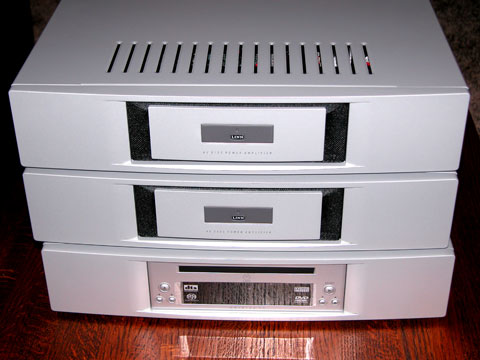
A pair of the Linn 5125 5.1 channel
switching amplifiers (top two units), resting on the Unidisk 1.1 -
engineering and beauty need not be polar opposites.
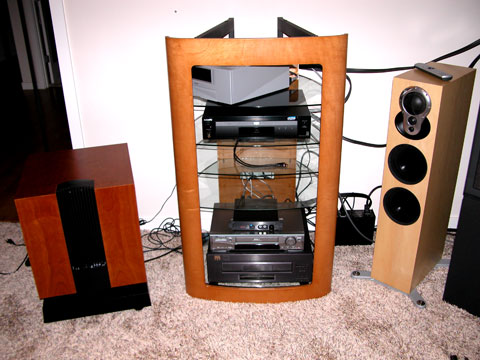
The new audio rack in the middle of setup
and component shifting. On the bottom shelf is the Theta Data III
Laserdisc player, with the Mitsubishi D-VHS/S-VHS VCR, and the Benchmark
DAC1 (Laserdisc playback only, and since returned to Benchmark). The
second shelf down has the old Sony DVD player, soon to retire to another
room.
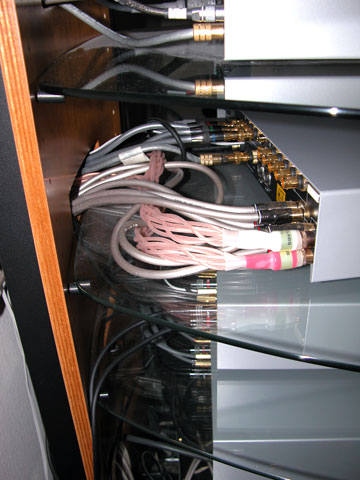
A rear view of the Unidisk 1.1, showing
the final cabling configuration. Don't try this at home, children!
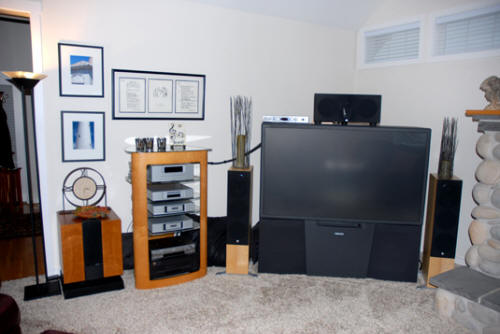
The new Linn system in place …quite an
improvement from the previous setup!
It took Brian and me a couple of days to get
everything more or less in place. Bravo to Maestro Morris for his
meticulous work, and for his ability to get everything possible from the
Linn surround system in its "shift to stage left" configuration. Once we
finished, and gave it some listening to make sure that all was well,
Brian departed. I dug in on the break-in both of video and audio.
Months passed…which was necessary, since the
Akurate speakers do require a couple of hundred hours of vigorous
workout to hit their stride. The Akurates that I have here are the
passive models, by the way; Linn also has an active (powered) version of
its home theater speakers. I have always preferred Linn's active
speakers to their passives, but I've have to say that these passive
Akurates have nothing to be embarrassed about. The punchy 5125
amplifiers in bi-amp mode do just fine, thank you kindly!
Impressions: the Sound of One Linn
Klapping
There are audiophiles who have combined
their love of audio (stereo and multi-channel) and video into a single
system in a single room. They claim that they are able to find a golden
mean that allows them to enjoy both types of playback without
discomfort. That may be so for them; long ago I gave up arguing with
anyone about their taste in musical playback. (And wine. And cigars. And
single malts. And cars. And women. You get the drift.) Nevertheless, and
no matter what anyone else might prefer, I have to say that I believe
videophile/surround sound systems operate according to different
expectations than an audiophile's stereo system does. In brief, I
believe that we are looking for fundamentally different experiences in a
home theater room than we are in a listening room.
This is no surprise; I'm looking for
something different at a concert than I am at a film theater, too.
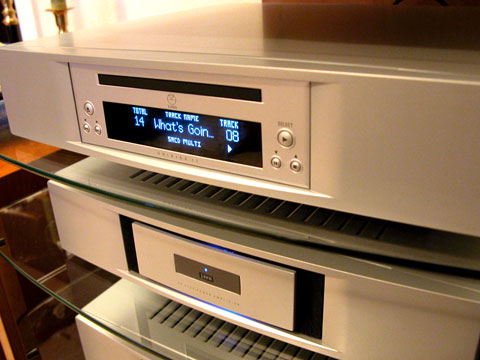
The Unidisk 1.1 playing a Michael
McDonald SACD in surround mode - righteous stuff!
When I go into a listening room optimized
for fine stereo playback, I'm looking for qualities like transparency,
detail, tonal rightness, soundstage breadth and depth, and proper
dynamics. When things are right, I dim the lights, relax into the sound,
and usually close my eyes. I measure the excellence of stereo sound
reproduction by the degree of introspection it compels in me.
Surround sound systems can be quite
rewarding—I've heard exceptional examples from the likes of Sony/Philips
(CES 2001) and Ray Kimber (his brilliant IsoMike™ DSD recordings played
back via EMM Labs multi-channel over the past several years)—but they
are challenging to set up correctly, and place a real premium on space.
Done right (and contrary to the audio contrarians), they can extend the
delight and introspection of one's experience of recordings, especially
from SACD done from DSD sources. Done wrong, they're pretty bad; who
needs ping-pong sound in six channels? The result is a long way from
introspection.
Home theater, on the other hand, is almost
always optimized as a dynamic experience, above all. Most sound
tracks nowadays are hardly exercises in restraint, nuance, or
transparent detail; car chases, explosions, violent conflicts, and the
excesses of technical effects nuke audiophile values like "inner detail"
or "microdynamics."
Think "Technicolor."
Or Red Book PCM.
"Same difference," a friend of mine used to
say.
All of a qualitative family.
The cynical audiophile might note that the
compressed limitations of Dolby Digital has a tendency to "dumb down"
the sound, much the same way that the uncontrolled use of compression in
modern recording and FM playback has produced an undifferentiated muck
for the listener. (No wonder your typical iPod user considers the
quality of his or her playback to be so striking; compared with the
noise floor of our contemporary culture, in some ways it is.)
Then again, cynicism may well be the last
refuge of perceptive sensibilities.
Can surround sound/home theater systems be
restrained from the trap of the bomb(astic) above all? Of tiresome
tinnitus-inducing trauma at all times? Of boomboxery times 5.1?
My show experience has been discouraging. An
awful lot of home theater/surround sound systems that I've heard over
the past five years were little more than exercises in excess. Probably
the worst that I saw was Tomlinson Holman's demonstration of his "10.2"
(with only 10.1 installed …the other sub was MIA) surround system at CES
in 2001. Ping pong (literally) in ten channels, and thus pretty dreadful
all around. I've heard many other bad rooms since then, though; the same
thing, only on a smaller scale. You know: Terminator 2, Star
Wars I/II/III/IV/V/VI, [insert your favorite car-chase flick], at
shrieking volumes in relatively small rooms.
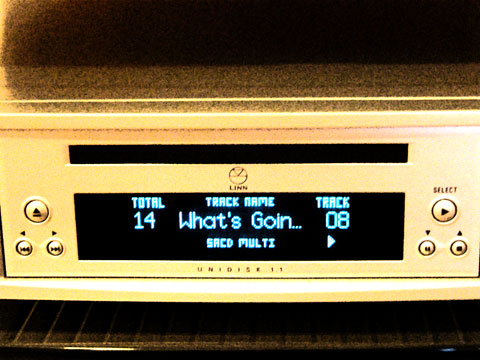
I was hopeful that the Linn Kisto/Unidisk
1.1/Akurate system would rescue our home theater/surround room from such
multi-channel mediocrity.
I'm very glad to say that it has done so—and
exceptionally—which I was not sure would be the case when I took the
project on.
I commented on the excellent stereo playback
of the Unidisk 1.1 back in PFO Issue 16 (see
https://positive-feedback.com/Issue16/unidisk1.1.htm), and have
nothing to add to that very favorable commentary. As a stereo SACD and
CD player, the Unidisk 1.1 is absolutely terrific.
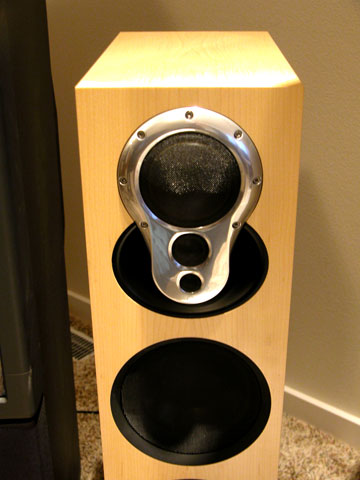
The Linn Akurate 242, upper section, with
its magnetically attached speaker cover removed. The 3-K driver array
(midrange, tweeter, and super-tweeter) is floating in the silver frame
above the mid-bass. Note that there is another woofer lurking just
outside of the lower edge of the frame. Linn lists the frequency
response of this 5-way passive system at a nominal 49Hz - 33kHz @ 8
ohms, with the subwoofer shouldering the balance of the bass playback.
On the multi-channel side of things, the
Unidisk 1.1/Kisto/Akurate system showed itself to be highly
synergistic…not shocking at all, given the fact that unlike most fine
audio manufacturers, Linn is able to provide a truly complete system,
from source components to cables and speakers. This equipment was
made to work together magnificently, and sounds like it. Instead of
sounding boomy, brash, forward, or tubby, the Akurate playback system
was clean and coherent. I haven't noticed any boxiness in the sound
during either SACD surround or DVD video/Dolby Digital 5.1 playback;
there's a very fine transparency to audio playback with the Akurate
surround system.
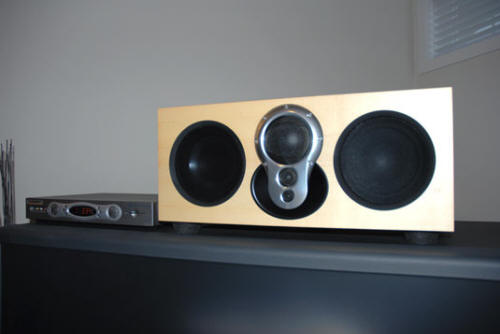
The Linn Akurate 225 5-way center channel
speaker in place on the Toshiba HDTV. The 3-K array is used on this
speaker, as well. Linn lists the nominal frequency response at 66Hz -
33kHz @ 8 ohms for passive playback.
The pair of 5125 switching amplifiers in
tandem with the Akurate speakers provided a sound that was clean, quick,
rich, and always very musical. Though the Akurates may look like
customary floor-standing speakers, their 3-K speaker array with its
near-point-source reproduction provided excellent coherence of audio
reproduction. Surround music on SACD has a natural ease, with just a
touch of warmth, without loss of detail or a movement to romantic gush.
True DSD surround recordings were especially pleasant. For example, the
Tilson-Thomas/San Francisco Mahler cycle (a truly superlative
reference-grade series …if you don't have the whole set yet, get it!) is
absolutely magic via the Unidisk 1.1/Kisto/Akurate system. I love the
sense of spaciousness and fine presence that Linn is able to provide in
our great room …and so have all of our visitors. (Once recent visitor
couldn't quit smiling; a Maggie 3.6 planar owner himself, he said that
he couldn't believe that dynamic speakers could sound so clean
and unboxlike. Yep …they can.)
I should say in passing that while DVD-A is
not my preferred format, I found that the Unidisk 1.1 did a very fine
job making hi-resolution PCM and PCM surround sound…well, less
objectionable. My DVD-A of the Greatful Dead's Workingman's Dead,
or REM's Automatic for the People played back creditably via the
Linn system. (Of course, with such terrific music I'll freely confess
that I'm pretty forgiving with the drawbacks of DVD-A.) While I consider
DVD-A to be an unfortunate format, there is some good music that was
issued this way. If you want to hear it at its best, the Unidisk 1.1
does the job. Likewise well rendered were DTS surround disks. I don't
have too many of these, but purchased a few to see how they would play
back on the Unidisk 1.1. Not bad, as it turned out …DTS audio turned out
to be tolerably listenable with the Linn gear, though I found it to be
nowhere near the excellence of SACD surround. No shocker, that, I guess.
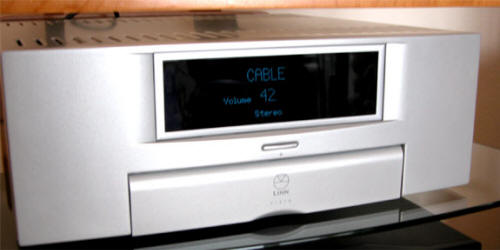
The beautify and sophisticated Linn Kisto
System Controller in action - in this case, handling a stereo HD feed
from Comcast.
On the DVD video/Dolby Digital side of the
ledger, the performance of the Linn system was a pleasant revelation.
Video playback was certainly a step forward from the Sony player that I
had been using earlier: images from the Unidisk 1.1 via the Kisto (using
component connections) provided a viewing experience on the 65" Toshiba
that were freer from video noise, particularly in the deeper reds. (I
should mention that I have calibrated the Toshiba using the Video
Essentials disc. If you don't have this valuable tool for your home
theater system, you really ought to get it and use it. Most video
playback is poorly calibrated for true NTSC; the default from the
factory is usually TECHNICOLOR …a preference for garish rather than
realistic color.)
One of the most problematic DVDs that I
know of for dark scenes and deep reds is The Relic. The Unidisk
1.1/Kisto made my earlier Sony look confused by comparison; instead of a
somewhat muddy and bled-out presentation, the Linn system provided
greater resolution of the troublesome "red zone" throughout The Relic.
Ditto with the gloom in movies like Pitch Black and Aliens;
muddy and vague rendition of shadows and glowing reds was knocked back
noticeably.
Better yet, in the Linn system black and
white classics were presented without the tendency to produce "chroma
shimmer," that bothersome color noise that causes intermittent
coloration of black and white scenes—where it definitely doesn't belong.
This makes viewing Citizen Kane, Psycho, Touch of Evil,
or Casablanca a distinct delight, instead of causing me to grind
my teeth in frustration. (My dentist is pleased!)
I also note that pixelization in scenes with
rapid motion were reduced with the Unidisk 1.1/Kisto, though DVD video
as a format doesn't seem to have completely dealt with this problem yet.
Very rapid movement still seems to provoke pixel blocking in digital
video playback in my system. I should note that my Toshiba HDTV is a
first-generation model; even with the Unidisk 1.1/Kisto, pixelization
isn't eliminated. We are considering an upgrade to the latest generation
HDTV playback in 2007, with modern I/O so that we can essay HDMI and
1080p. Perhaps this will help DVD playback, though I suspect that faster
video processing and larger video bit-words are ultimately the only
solution. (Blu-Ray and HD-DVD playback is something that I will also
essay in 2007, just to see whether these formats can overcome this
problem via higher resolution. I certainly hope so.)
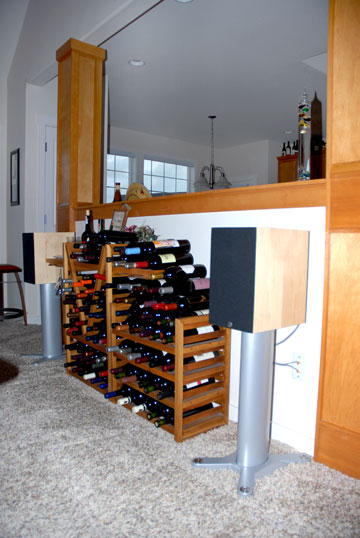
The Linn Akurate 212 4-way Rear Channel
Speakers on their dedicated stands. These speakers also feature the 3-K
speaker array, and thus share the coherence of their larger siblings.
Linn lists their response as 70Hz - 33kHz @ 8 ohms nominal. The
efficiency of the Akurate line is a low-middling 87dB/watt/meter; this
means that you'll want to have plenty of power for a surround system.
I must say that the sound tracks that the
Linn system delivered for DVD videos were really spectacular. Even in
passive mode—and even with all the inherent limitations and compression
of Dolby Digital—the Unidisk 1.1/Kisto/Akurate delivered plenty of the
punch!/biff!/bam!/BOOM!!! that home theater devotees appreciate,
while not losing their way when playing back more subtle surround
material (see above). For example, the crash scene at the opening of
Pitch Black (a personal BOOM!!! reference for me) was dynamic, deep
and piercing …scary good. In fact, I had to be careful with the playback
volume; the Linn system drives some pretty definite SPLs. Another
reference scene for me is the opening submarine disaster in The Abyss,
which the Unidisk 1.1/Kisto/Akurate handled well …deep and explosive.
Ditto the crazy chase scene in Terminator 2, or the shoot-out
scene near the end of The Matrix; given non-maniacal playback
levels, the 5125 amps had no problem delivering the dynamic goods.
Music videos were also enjoyable with the
Linn system. Favorites like the Talking Heads Stop Making Sense,
or Rush's 2004 concert in Germany (in high definition, no less!)
definitely hit the spot; ditto with my VHS (not available on DVD) of Lou
Reed's remarkable Magic and Loss. Is it like listening to SACD in
surround? Don't I wish! No, you have to take most music videos as they
are, and let the video fill in the blanks. For me, it's a willing
suspension of distress, which is otherwise what I would feel at the
quality of the audio that is usually conveyed on these discs. (Dolby
Digital = PCM, in compressed mode, no less.)
Who knows? Perhaps Blu-Ray with its sub-spec
of DSD/SACD will one day deliver high definition video AND high
resolution DSD 6-channel soundtracks ...which would be the top o' the
heap for both worlds.
Sony? Anybody over there listening? (Naaah!
Too busy building PS3s!)
Overall, and despite these format drawbacks
for DVD movies and music, the Linn gear definitely upgraded my home
theater experience on both the audio and video fronts.
What about standard TV operation? Cable TV
playback from our Comcast high definition feed, via our DVR-equipped
Comcast tuner box, has been very satisfactory with the Kisto.
Interestingly, the Kisto is a complete system controller, and so both
audio and video feeds are handled by this brilliant component. Both
audio and video inputs/outputs are programmed via the Kisto's very
powerful menuing operating system. This allows the user to configure and
bond video and audio I/O with complete flexibility, and get precisely
the parameters that you require. Naturally, as I noted earlier, this
much power and control means that there is complexity; the end user will
have to either learn the OS, or will have to get a professional to do
the setup in their home theater room. (I'd strongly recommend this
option to anyone who is not either a trained home theater installer or
an Information Technology specialist. Seriously.) Once you get the hang
of it—and I have—then it's pretty simple to take a given set of video
inputs, bond them to an appropriate set of audio inputs, then send the
output to the correct audio/video pipes.
I should also say that the Linn remote
control works magnificently with the Kisto and Unidisk 1.1. Once the
programming of the Kisto and Unidisk are done, it is simplicity itself
to use ONE SINGLE REMOTE to handle all the audio and video input/output
functions. Given the pathetic tangled thicket that most home theater
setups subject their users to, it is quite refreshing to find advanced
sophistication and ease of use in a single remote control system. This
bloody system works!
How's standard NTSC and HD playback via the
Kisto? Subject to the usual limitations that may exist in your cable
system, I'd say that they were excellent. Certainly my Comcast loop is
delivering first-rate signal (analog NTSC, digital NTSC, and HDTV) which
is handled with the greatest of ease by the Kisto. Portland being the
hot bed of HDTV that it is, I was also able to check the quality of the
handling of off-the-air HD signal via the Linn, through a Samsung HD
broadcast decoder that I own. This was no problem at all for the Kisto;
we simply defined a broadcast I/O set and fed it to the Toshiba and the
Akurate surround system. Once it's set up, the Kisto worked like a
charm.
All this, and reliability too
The prolonged stay of the Linn surround
setup, regrettable as it has been for timeliness, has given me one
particular opportunity, however—it has allowed me to assess the Linn
gear for quality over time, both sonically and in terms of reliability.
This is a real luxury for a reviewer; most review projects are over and
done with in a few weeks to a few months; this one allowed me to gain a
greater perspective on the gear.
The result: since the completion of the
installation, I have put in literally many hundreds of hours on the Linn
Kisto/Unidisk 1.1/Akurate and their associated components. They have
been on continually, without any significant shutoff, for nearly two
years. Every hour of television, DVD video, VHS, laserdisc, and
music playback in all modes (SACD/CD stereo, SACD surround, DVD-A
surround, DTS, and Dolby Digital in its various incarnations) that I've
done in my home theatre room for the past 24 months has transited the
Linn. What have my findings about its reliability been?
First of all, and no surprise, the Linn
designs have shown themselves to be remarkably reliable and stable. In
two years I have seen only one glitch, and that was when the Unidisk 1.1
developed a thermal problem. It was a very early production sample with
inadequate ventilation; it was replaced by Linn with an improved model
(see my Brutus Award winners for 2006), which has worked flawlessly ever
since. Other than that, there has been nothing to complain about; the
performance of the Kisto/Unidisk/Akurate speakers and the 5125
amplifiers have been all that I would expect from Linn.
Upgrades are usually done by flashing the
firmware; Linn provides a procedure so that the tech-savvy user can do
this for him- or herself, or your Linn dealer can run the procedure for
you. Linn scores points with me for the intelligence of their approach
to the Kisto operating system and the firmware in the Unidisk 1.1.
Programmability extends the life and utility of components like these in
a way that increases the return on investment for the end user quite
nicely. New features can be added, and the capability of the Kisto can
be extended without debilitating down-time. Flashing the firmware also
increases reliability by providing fixes for firmware problems that
might turn up.
After 24 months, I have reached the point at
which I can say with real confidence that Linn's very ambitious Unidisk
1.1/Kisto tandem is a reliable winner, and that videophiles can
invest in the Linn system without worrying about having components that
will either go immediately out of date or will fail without due cause.
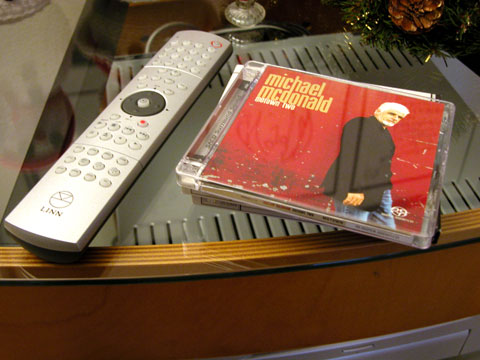
The very attractive and powerful Linn
remote control, providing complete direction for the Kisto and the
Unidisk 1.1.
A few caveats for our readers…
That's not to say that there aren't a few
things for the reader to consider with the Linn system. Let me summarize
the caveats:
-
First, remember (once more) that the
Linn Unidisk 1.1/Kisto/Akurate system is complex and
powerful. Most purchasers will want to be sure that a trained
Linn home theater technician handles the installation and
configuration for them. Even if this means paying some additional
funds, please do so: protect your investment!
-
Second, the Linn Unidisk 1.1, Kisto, and
their associated surround amplification generate heat. Do
not install this system in any rack or audio-video storage
system that does not assure plentiful ventilation, as I can almost
guarantee that you will risk thermal failure …a very ugly tragedy
with such fine equipment.
-
Third, while I enjoy the Akurate passive
speakers, their only moderate 87dB/Watt/meter efficiency means that
you will have to make sure that you have plenty of surround
amplification installed. I have a pair of the Linn 5125 switching
amplifiers, as noted, delivering 1000 watts (5 channels x 200 watts)
but there were several times when I was able to drive the 5125s
into very mild clipping at higher volume levels. If I had it to do
over again, I would definitely go with the active (powered) Akurate
speakers to get some more oomph and control into the playback, and
remove some of the load from the amplifiers. (It's that, or purchase
more amplifiers!) If you like higher SPLs for your home theater, or
want maximum dynamics without the likelihood of clipping, you'll
need to keep this in mind. This is especially true if you have a
larger home theater room! Remember that larger cubic footage means
that you'll need more amplification, or active speakers.
-
Fourth, videophiles looking for HDMI
(for 1080p) or DVI connectivity will need to be aware that the
Unidisk 1.1 and the Kisto do not currently handle such I/O
requirements. 1080p is new enough that it is still arriving as the
latest standard, so it is no surprise that the Kisto does not
feature the interfaces. If Linn develops such capabilities in the
future, I'll be sure to inform our readers.
-
Finally, the Linn Unidisk 1.1/Kisto/Akurate
system is of such high quality that you'll want to be sure you match
it with an appropriately high quality HD monitor or projection
system. Don't cast your Linn pearls before outmoded video swine.
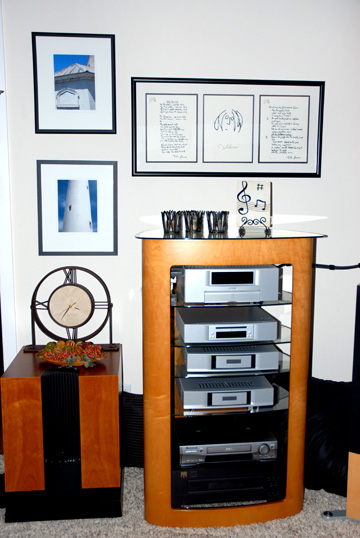
Conclusion
Well, here at the end of an extended time
with the Linn Unidisk 1.1, Kisto, 5125 amplifiers, the Akurate speaker
system, and the Melodik subwoofer, what conclusions have I come to? I
can say that the Linn system represents a truly superior combination of
beauty, performance, robustness, and proven long-term reliability. With
the Unidisk 1.1, audiophiles and videophiles alike will find that all
established major 'phile-approved audio and video standards are
available to them. (Remember that the struggle between Blu-Ray and
HD-DVD is too recent to count.) The Kisto is a marvel of power and
flexibility as a system controller/processor, with little left over to
wish for. And Linn amplification drives the very fine Akurate speaker
system in ways that will satisfy both lovers of musical nuance as well
as videophiles who demand BIG-TIME BOOM!!!
Elegance—and power; with the Linn Unidisk
1.1/Kisto/Akurate system, you can …and do …have both. And
once you have it, you definitely won't want to go back to
anything lesser for surround sound or for home theater.
The Linn Unidisk 1.1/Kisto/Akurate system
(with associated Linn electronics and subwoofer) therefore richly
deserves a "Ye Olde Editor's Very Highest Recommendation!"—and
with the greatest enthusiasm.
Consider it given…
Prices of current production units reviewed
(all USD):
Linn Unidisk 1.1, $10,995
Linn Kisto, $12,995
Linn Akurate 242 L/R front, $9545/pair
Linn Akurate 212 L/R rear, $5750/pair,
plus optional stands at $900/pair
Linn Akurate 225 center channel, $3750
Note that the Linn Melodik subwoofer and
the 5125 switching amps are no longer in production.
Linn, Inc.
For more information, or to find a Linn dealer near you, see
http://www.linn.co.uk.
|
